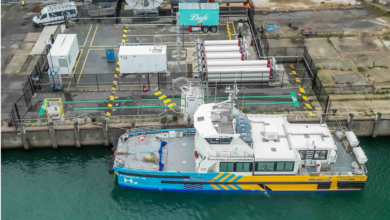Duisburg container terminal goes climate-neutral using hydrogen
The world’s largest inland port will become climate neutral with Rolls-Royce hydrogen technology.

At the Port of Duisberg in Germany, a new container terminal is currently under construction and is working with several partners to ensure the energy supply to the terminal is climate neutral.
To do this it is building a hydrogen-based supply network ready for operation by 2023. It will include several technologically sophisticated options for energy conversion and storage. Our mtu fuel cell solutions for electrical peak load coverage and mtu hydrogen heat and power generation station will supply the future terminal with electrical energy and heat in a sustainable way.
As one of the fuels of the future and as an essential building block for the energy transition, hydrogen will play a central role when, in a few years’ time, Duisburg, Europe’s largest inland port, shows what the energy supply of the future may look like: decentralised and climate-friendly. The largest container terminal in Europe’s hinterland is currently being built on the former coal island, once a transhipment point for bulk cargo. It will set not only new standards in cargo handling but also in climate-friendly energy supply. The main role in this project, called “enerport II”, is played by fuel cells and mtu hydrogen engines – each with different tasks.
The hydrogen-powered mtu fuel cell solutions supply electrical power as soon as the public power grid reaches its limits, for example, for the onboard power supply of ships berthed in the port or in the event of other load peaks.
In addition, two combined heat and power plants with mtu hydrogen engines convert hydrogen energy into electrical energy, which is fed into the supply network of the future container terminal or into the public grid. The waste heat is used for process heat or for heating buildings in and around the port. The project is being funded by the German Federal Ministry for Economic Affairs and Energy for a period of four years as part of the “Hydrogen Technology Offensive”.
Andreas Schell, CEO of Rolls-Royce Power Systems, said, “The parallel use of fuel cell solutions and hydrogen engines shows that we have taken the right path with our technology-open approach to the development of new solutions for the energy supply of the future.”
